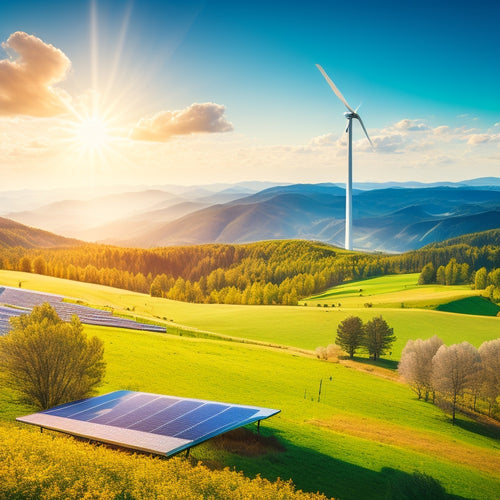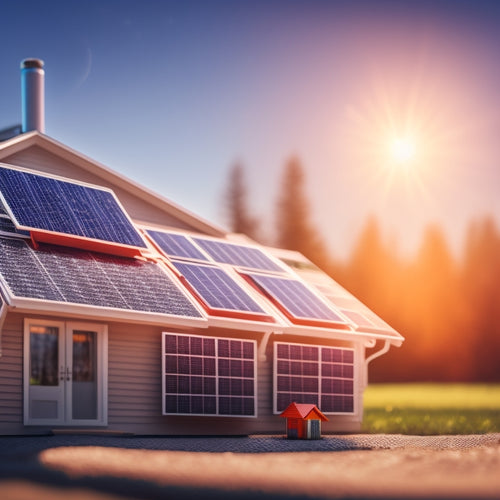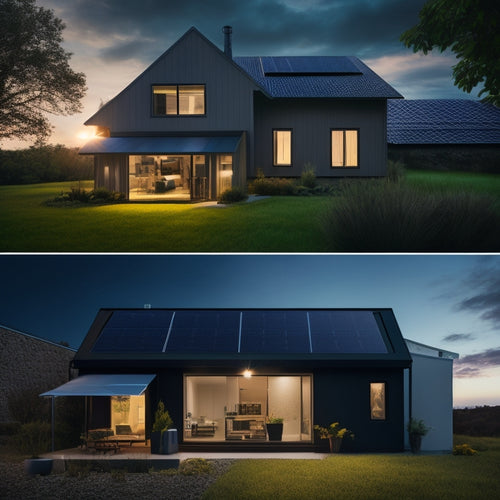
Tiny Solar Panel
Share
You're considering a tiny solar panel, a compact power solution that utilizes solar energy in an extraordinarily small package, allowing you to generate power anywhere, anytime, while enjoying the freedom and independence that comes with it. These panels are engineered for portability, featuring lightweight designs, foldable frames, and waterproof enclosures, making them ideal for outdoor enthusiasts, remote workers, and off-grid homesteaders. With high power density and energy efficiency, tiny solar panels can generate more power per unit area, and advancements in technology enable higher outputs in smaller sizes. As you investigate tiny solar panels, you'll uncover the complexities of wattage and voltage considerations, frame material options, and more.
The Essentials
- Tiny solar panels offer portable and compact power solutions ideal for on-the-go energy needs, providing freedom to generate power anywhere.
- High-efficiency photovoltaic cells maximize energy conversion, and advanced materials like perovskites improve power conversion rates in tiny solar panels.
- Compact designs with foldable solar panels enable easy transport and maximize energy output in minimal space, making them perfect for outdoor enthusiasts.
- Accurate wattage measurement and voltage rating considerations are critical for tiny solar panel selection to ensure power requirements are met and prevent damage.
- Lightweight and durable frame material options like aluminum, stainless steel, or titanium enhance the overall performance and reliability of tiny solar panels.
Portability in Small Size
You'll appreciate the compact power solution that tiny solar panels offer, making them ideal for on-the-go energy needs.
With the ability to provide a reliable and renewable source of energy, they're perfect for off-grid excursions and everyday convenience.
Their lightweight design enables you to carry a reliable energy source without adding bulk to your gear.
As you consider portable energy options, the tiny solar panel's small size and weight make it an attractive choice.
Compact Power Solution
Within the confines of a tiny solar panel, an extraordinary compact power solution is engineered, allowing users to employ the energy of the sun in an extraordinarily small size.
This miniature energy system is designed to provide you with the freedom to generate power anywhere, anytime. You can exploit the sun's energy to charge your devices, power your equipment, or even energize your home.
With the advancement of foldable solar panels for travel, the compact design is made possible by advanced solar innovations that maximize energy output while minimizing physical space.
You'll be amazed at how much power you can generate from a device that fits in the palm of your hand.
With a tiny solar panel, you're no longer limited by traditional power sources. You can take your energy generation with you, wherever you go.
Whether you're an outdoor enthusiast, a remote worker, or an off-grid homesteader, this compact power solution is the key to releasing your independence.
Lightweight Energy Options
As the tiny solar panel's compact design allows users to generate power anywhere, its lightweight energy options become a significant advantage. You can now carry power with you wherever you go, without the burden of heavy equipment. This freedom to generate power on-the-go is made possible by the latest solar innovations that prioritize portability.
| Feature | Weight | Benefits |
|---|---|---|
| Foldable Design | 1.5 kg | Easy to carry and store |
| Slim Profile | 0.5 kg | Fits in backpack or purse |
| Waterproof Enclosure | 0.2 kg | Durable and weather-resistant |
With sustainable technology like this, you can investigate the great outdoors without worrying about running out of power. Whether you're a hiker, camper, or festival-goer, the tiny solar panel's lightweight energy options guarantee you stay connected and powered up. Its compact size and minimal weight make it the perfect companion for any expedition. By utilizing the power of the sun, you can enjoy the freedom to roam wherever you please, without being tied down by bulky equipment.
Increased Energy Efficiency
You'll benefit from the tiny solar panel's increased energy efficiency, which stems from its high power density and low energy loss.
With top-rated solar panels, you can maximize your energy savings and reduce your reliance on traditional energy sources renewable energy solutions.
This means you can generate more power per unit area, resulting in a more efficient energy harvesting system.
High Power Density
One significant advantage of tiny solar panels lies in their high power density, which translates to increased energy efficiency. This means you can generate more power in a smaller area, making them ideal for applications where space is limited.
With high power density, you can maximize your energy output while minimizing the physical footprint of your solar installation. This is particularly important for urban areas where rooftop space is scarce.
In terms of solar technology, high power density enables more efficient energy storage and reduced installation costs. As the market trends towards sustainable energy solutions, tiny solar panels with high power density are becoming increasingly popular.
Their cost efficiency and environmental benefits make them an attractive option for those seeking to reduce their carbon footprint. Furthermore, high power density solar panels require less maintenance and are suitable for a wide range of user applications, from residential to commercial installations.
Low Energy Loss
Tiny solar panels boast another significant advantage: low energy loss, which directly correlates to increased energy efficiency. This means you'll generate more power while minimizing waste. When you're off the grid, every watt counts, and low energy loss guarantees you're maximizing your energy harvest.
In traditional solar panels, energy loss occurs due to heat, resistance, and other inefficiencies. However, tiny solar panels have been engineered to mitigate these losses.
With advanced materials and optimized design, they can convert sunlight into electricity with extraordinary efficiency. This translates to more power for your devices, appliances, and tools.
High-Efficiency Photovoltaic Cells
You're about to investigate the advanced technology behind high-efficiency photovoltaic cells, which are essential for tiny solar panels.
These cells are designed to enhance cell efficiency, allowing them to convert a higher percentage of sunlight into electrical energy.
With the increasing demand for renewable energy and sustainable power solutions, high-efficiency photovoltaic cells play a significant role in reducing carbon footprint and electricity bills.
Cell Efficiency Boosting
High-efficiency photovoltaic cells have become an integral component in the development of tiny solar panels, as they facilitate the conversion of a higher percentage of incident sunlight into electrical energy.
You're probably wondering how these cells achieve such high efficiencies. The answer lies in advanced cell design and innovative solar materials. By optimizing cell design, manufacturers can minimize electrical losses and maximize photon absorption. This is achieved through techniques such as surface texturing, anti-reflective coatings, and advanced doping techniques.
Additionally, new solar materials like perovskites and bifacial cells have shown promising results in enhancing cell efficiency. These materials have higher power conversion rates and can capture energy from both the front and back sides of the cell.
As you investigate the world of tiny solar panels, you'll find that high-efficiency photovoltaic cells are vital in revealing the full potential of these devices. By pushing the boundaries of cell design and solar materials, you can expect even higher efficiencies and more powerful tiny solar panels in the future.
Maximum Power Output
When it comes to tiny solar panels, maximizing power output is essential, and high-efficiency photovoltaic cells play an important role in achieving this goal. You want to get the most out of your tiny solar panel, and that means optimizing power output.
High-efficiency photovoltaic cells are designed to convert sunlight into electrical energy with minimal loss. This is critical in tiny solar panels, where every watt counts.
To achieve maximum power output, you'll want to focus on power optimization. This involves selecting solar cells with high energy conversion rates and configuring them to minimize energy loss. By doing so, you can squeeze every last bit of power out of your tiny solar panel.
Advances in solar technology have made it possible to achieve higher power outputs in smaller form factors. By leveraging these advancements, you can create tiny solar panels that are both efficient and effective.
With high-efficiency photovoltaic cells and power optimization, you can unleash the full potential of your tiny solar panel and enjoy the freedom that comes with reliable, renewable energy.
Check Wattage and Voltage
When selecting a tiny solar panel, you'll need to take into account two critical factors: wattage and voltage.
As you investigate residential solar power systems, you'll want to accurately measure the wattage to guarantee it meets your power requirements.
You should pay attention to the voltage rating to prevent damage to your system, especially when working with sensitive components like inverters and batteries.
Wattage Measurement Tips
You'll need to measure the wattage of your tiny solar panel to verify it's performing efficiently. To do this, you'll need to calculate the wattage using the formula: wattage (W) = voltage (V) x current (I).
Make certain you have the necessary measuring tools, such as a multimeter or a wattmeter, to accurately measure the voltage and current outputs of your solar panel.
When measuring, connect the multimeter or wattmeter to the solar panel's output terminals. Set the device to measure voltage and current simultaneously. Take multiple readings under different lighting conditions to get an average value. Record the maximum and minimum values to understand the panel's performance range.
For accurate wattage calculation, consider the panel's maximum power point (MPP). This is the point at which the panel produces its maximum power output.
You can use a maximum power point tracker (MPPT) to optimize the panel's performance and get the most accurate wattage measurement. By following these tips, you'll be able to accurately measure your tiny solar panel's wattage and make certain it's operating at its best.
Voltage Rating Importance
With your tiny solar panel's wattage measurement in hand, it's vital to understand the voltage rating's significance to guarantee peak performance. You see, voltage stability is key to ideal performance, and neglecting it can lead to subpar energy harvesting.
As you investigate the world of tiny solar panels, you'll come across various voltage ratings, typically ranging from 5V to 24V.
When selecting a tiny solar panel, make sure the voltage rating aligns with your project's requirements. A mismatch can result in reduced efficiency, overheating, or even damage to your system. For instance, if your device requires 12V, using a 24V solar panel can lead to energy waste and decreased performance.
To achieve ideal performance, it's important to maintain voltage stability within the recommended range. This guarantees your tiny solar panel operates within its design parameters, providing consistent energy output.
Lightweight Aluminum Frame Design
You're tasked with designing a tiny solar panel's frame, and you're considering lightweight aluminum as the primary material.
You'll need to investigate various frame material options to guarantee the structure meets the required strength, durability, and weight standards.
Aluminium's high strength-to-weight ratio makes it an attractive choice, but you'll need to weigh it against other options, such as anodized or powder-coated aluminum, to determine the best fit.
Frame Material Options
Beyond the photovoltaic cells, the frame of a tiny solar panel plays an essential role in its overall efficiency and durability. You'll want a frame that's both strong and lightweight to maximize energy output while minimizing weight and cost.
When it comes to frame material options, you have several choices. Aluminum is a popular choice due to its high strength-to-weight ratio, corrosion resistance, and affordability. However, you may also consider stainless steel or titanium for added durability and aesthetic appeal.
For a more budget-friendly option, anodized aluminum frames offer a durable and corrosion-resistant solution. Additionally, you can opt for a frame with a powder-coated finish to enhance frame durability and reduce maintenance.
Whatever material you choose, make sure it meets your specific requirements for frame durability, weight, and aesthetic appeal. By selecting the right frame material, you'll be able to create a tiny solar panel that's both efficient and reliable, giving you the freedom to generate clean energy wherever you go.
Frequently Asked Questions
Can Tiny Solar Panels Be Used to Charge Electric Vehicles?
When charging your electric vehicle, you're wondering if small-scale solar power can get the job done. Yes, you can use tiny solar panels, but consider the trade-offs: lower charging efficiency versus increased portability options, giving you freedom to charge on-the-go, but at a slower pace.
Do Tiny Solar Panels Require Special Installation Skills?
When tackling installation projects, you'll find that certain systems demand specialized skills, but with DIY-friendly installation techniques, you can overcome these obstacles, enjoying the freedom to manage your own renewable energy setup, even with tiny solar panels.
Are Tiny Solar Panels Affected by Shade or Cloud Cover?
You'll find that solar panels, in general, are affected by shade and cloud cover, which reduce their energy output. Shade has a significant impact, while cloud cover decreases efficiency by up to 20%.
Can Tiny Solar Panels Be Connected to a Battery Bank?
Like a skilled puzzle solver, you'll find connecting batteries to a power source a breeze. When it comes to connecting to a battery bank, you can, and it's a great way to store excess energy for later use, allowing for an efficiency comparison and enhancing overall power output.
Are Tiny Solar Panels Suitable for Use in Extreme Weather Conditions?
When evaluating solar panels for extreme weather, you'll want to assess their performance metrics, such as temperature coefficients and humidity tolerance, which are critical in durability tests, ensuring your energy independence isn't compromised by harsh conditions.
Final Thoughts
As you hold the tiny solar panel in your hand, it's like grasping a miniature sun, utilizing the power of the stars in a device no larger than a palm. This tiny titan packs a punch, with increased energy efficiency and high-efficiency photovoltaic cells that convert sunlight into electricity with precision. With a lightweight aluminum frame design, it's the perfect companion for your next journey. Check the wattage and voltage to reveal its full potential, and release the power of the sun in the palm of your hand.
Related Posts
-

Renewable Energy Solutions to Reduce Your Carbon Footprint
To reduce your carbon footprint, adopting renewable energy solutions is key. Using solar panels or wind turbines can ...
-

A Beginner's Guide to Navigating the Solar Investment Tax Credit
You're eligible to claim a significant Solar Investment Tax Credit (ITC) of 30% of total installation costs, but mane...
-

Cost of Home Solar Battery
You're looking to invest in a home solar battery to reduce your grid reliance, but you're curious about the cost. The...


